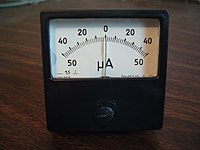Introduction:

Ammeter

Voltmeter
In our day today life, many times we require to measure different electrical quantities like current, voltage, resistance, etc. While doing experiment, there is necessity of multimeter. As we have already discussed about multimeter, how it measures different electrical quantities like electrical current, voltage, resistance, etc. But the basic instruments for the measurement of electric current and voltage are ammeters and voltmeters respectively.
Let us discuss these instruments one by one, operating principle (working principle) of ammeters and voltmeters, finally major differences between ammeters and voltmeters.
Operating Principle:
Analog ammeters and voltmeters are classed together as there are no fundamental differences in their operating principles. The action of all ammeters and voltmeters, with the exception of electrostatic type of instruments, depends upon a deflecting torque produced by an electric current .in an ammeter this torque is produced by a current to be measured or by a fraction of it. In a voltmeter this torque is produced by a current which is proportional to the voltage to be measured. Thus all analog voltmeters and ammeters are essentially current measuring devices.The essential requirement of measuring instruments are (i) that its introduction into the circuit, where measurements are to be made, does not alter the circuit conditions ;(ii)the power consumed by them for their operation is small.
Ammeters:
Ammeters are connected in the series with the circuit whose current is to be measured. The power loss in an ammeter is (I^2.Ra) where I is the current to be measured Ra is the resistance of the ammeter therefore ammeter should have low electrical resistance so that they cause a small voltage drop and consequently absorb small power.Voltmeters:
Voltmeters are connected in parallel with the circuit whose voltage is to be measured .the power loss in voltmeter is (V^2/Rv), where V is the voltage to be measured and Rv is the resistance of the voltmeter. Therefore voltmeters should have a high electrical resistance, in order that the current drawn by them is small and consequently the power consumed is small.Difference between Ammeters and voltmeters:
Parameters
|
Ammeter
|
Voltmeter
|
| Connection | It is to be connected in series mode | It is to be connected in parallel mode |
| Resistance | It has comparatively low resistance | It has high resistance |
| Uses | It is used to find the amount of current flowing in the circuit | It is used to find the potential difference in the circuit |
| Circuit | Circuit must be disconnected in order to attach the ammeter | Circuit does not need to be disconnected |
| Accuracy | Considered as less accurate | Considered as more accurate compared to ammeter |
Analog ammeters and voltmeters are classed together as there are no fundamental differences in their operating principles. The action of all ammeters and voltmeters, with the exception of electrostatic type of instruments, depends upon a deflecting torque produced by an electric current. In an ammeter this torque is produced by a current to be measured or by a fraction of it. In a voltmeter this torque is produced by a current which is proportional to the voltage to be measured. Thus all analog voltmeters and ammeters are essentially current measuring devices.
ReplyDeleteammeter 101